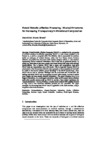Pulsed Melodic Affective Processing: Musical structures for increasing transparency in emotional computation
| dc.contributor.author | Kirke, Alexis | |
| dc.contributor.author | Miranda, Eduardo | |
| dc.date.accessioned | 2016-10-25T13:57:16Z | |
| dc.date.available | 2016-10-25T13:57:16Z | |
| dc.date.issued | 2014-05 | |
| dc.identifier.issn | 0037-5497 | |
| dc.identifier.issn | 1741-3133 | |
| dc.identifier.uri | http://hdl.handle.net/10026.1/6621 | |
| dc.description.abstract |
<jats:p> Pulsed Melodic Affective Processing (PMAP) is a method for the processing of artificial emotions in affective computing. PMAP is a data stream designed to be listened to, as well as computed with. The affective state is represented by numbers that are analogues of musical features, rather than by a binary stream. Previous affective computation has been done with emotion category indices, or real numbers representing various emotional dimensions. PMAP data can be generated directly by sound (e.g. heart rates or key-press speeds) and turned directly into music with minimal transformation. This is because PMAP data is music and computations done with PMAP data are computations done with music. This is important because PMAP is constructed so that the emotion that its data represents at the computational level will be similar to the emotion that a person “listening” to the PMAP melody hears. Thus, PMAP can be used to calculate “feelings” and the result data will “sound like” the feelings calculated. PMAP can be compared to neural spike streams, but ones in which pulse heights and rates encode affective information. This paper illustrates PMAP in a range of simulations. In a multi-agent simulation, initial results support that an affective multi-robot security system could use PMAP to provide a basic control mechanism for “search-and-destroy”. Results of fitting a musical neural network with gradient descent to help solve a text emotional detection problem are also presented. The paper concludes by discussing how PMAP may be applicable in the stock markets, using a simplified order book simulation. </jats:p> | |
| dc.format.extent | 606-622 | |
| dc.language | en | |
| dc.language.iso | en | |
| dc.publisher | SAGE Publications | |
| dc.subject | Communications | |
| dc.subject | human-computer interaction | |
| dc.subject | music | |
| dc.subject | affective computing | |
| dc.subject | Boolean logic | |
| dc.subject | neural networks | |
| dc.subject | emotions | |
| dc.subject | multi-agent systems | |
| dc.subject | robotics | |
| dc.title | Pulsed Melodic Affective Processing: Musical structures for increasing transparency in emotional computation | |
| dc.type | journal-article | |
| dc.type | Journal Article | |
| plymouth.author-url | https://www.webofscience.com/api/gateway?GWVersion=2&SrcApp=PARTNER_APP&SrcAuth=LinksAMR&KeyUT=WOS:000337567500009&DestLinkType=FullRecord&DestApp=ALL_WOS&UsrCustomerID=11bb513d99f797142bcfeffcc58ea008 | |
| plymouth.issue | 5 | |
| plymouth.volume | 90 | |
| plymouth.publication-status | Published | |
| plymouth.journal | SIMULATION | |
| dc.identifier.doi | 10.1177/0037549714531060 | |
| plymouth.organisational-group | /Plymouth | |
| plymouth.organisational-group | /Plymouth/Faculty of Arts, Humanities and Business | |
| plymouth.organisational-group | /Plymouth/Faculty of Arts, Humanities and Business/School of Society and Culture | |
| plymouth.organisational-group | /Plymouth/REF 2021 Researchers by UoA | |
| plymouth.organisational-group | /Plymouth/REF 2021 Researchers by UoA/UoA33 Music, Drama, Dance, Performing Arts, Film and Screen Studies | |
| plymouth.organisational-group | /Plymouth/Users by role | |
| plymouth.organisational-group | /Plymouth/Users by role/Academics | |
| dc.identifier.eissn | 1741-3133 | |
| dc.rights.embargoperiod | Not known | |
| rioxxterms.funder | Engineering and Physical Sciences Research Council | |
| rioxxterms.identifier.project | Brain-Computer Interface for Monitoring and Inducing Affective States | |
| rioxxterms.versionofrecord | 10.1177/0037549714531060 | |
| rioxxterms.licenseref.uri | http://www.rioxx.net/licenses/all-rights-reserved | |
| rioxxterms.type | Journal Article/Review | |
| plymouth.funder | Brain-Computer Interface for Monitoring and Inducing Affective States::Engineering and Physical Sciences Research Council |


